Once a marvel of imperial wealth, the now Yiheyuan or Summer Palace is perched on the Beijing hills and is a symbol of unequaled artistry and architecture throughout Chinese history. A mix of nature and human creativity, the UNESCO Heritage Site is one of the most gorgeous classical gardens in the world. For those wanting to delve into China’s rich culture, the Summer Palace is a must-visit location. This blog aims to unveil the Yiheyuan majesties alongside its fantastic scenery, historical value, and most famous sites and structures you should visit in Yiheyuan in 2025. Travelers, architecture fans, nature enthusiasts, or history buffs all have the chance to create memories of a lifetime.
What Makes the Summer Palace in Beijing a Must-Visit Attraction?
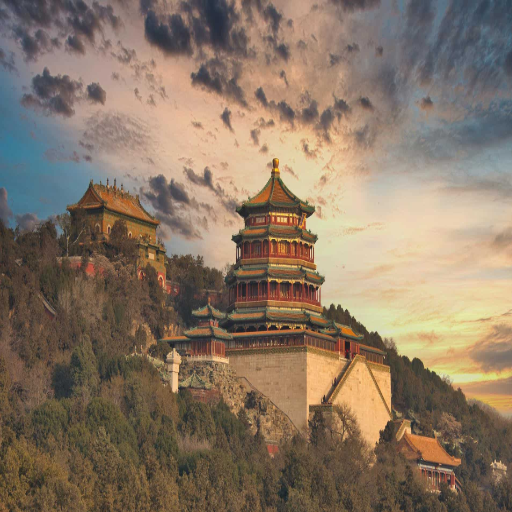
UNESCO World Heritage Site: Significance of the Summer Palace
A site of Summer Imperial Palace Gardens structures, the Summer Palace has been a UNESCO World Heritage Site since 1998 due to its historical and cultural significance as a masterpiece of Chinese landscape garden art. Its grand traditional Chinese style architecture, picturesque nature, and historical relics beautifully commemorate the Qing dynasty. Having 290 hectares of land, The Summer Palace contains primary sites such as Longevity Hill and Kunming Lake, which occupy around three-fourths of the area; the remaining area is dotted with pavilions, bridges, towers, and other structures designed to imitate the natural beauty of southern china known for its outstanding craftsmanship.
Its UNESCO designation emphasizes this site’s importance as a marker of China’s identity of China while portraying the harmony between construction and nature. The recognition also highlights its importance as an imperial retreat and a political landscape during the height. This remarkable work of architecture with breathtaking views has become a symbol of Chinese heritage, visited by millions of tourists annually.
The Imperial Garden’s History and Connection to the Qing Dynasty
Like most elements of Chinese culture, The Imperial Garden serves as evidence of the diverse landscaping features possessed by the Chinese people, which served a fundamental purpose during the Qing dynasty. It signifies a balance between man and nature, a core value of the Chinese way of life. Most emperors used the garden as a private getaway, facilitating the leisure, contemplation, and even the administrative activities of the emperors. The design was painstakingly crafted to incorporate intact elements of nature like water with constructed features like pavilions and corridors, creating a balanced ambient.
Layout Design: The layout of the feng shui garden has been designed with feng shui in mind, which determines the perfect location for water features, pathways, and mountains to ensure a positive energy flow.
Natural and Artificial Integration: The native flora and carefully crafted rockeries serve as an example of the merger of the manmade with the natural, reinforcing the Chinese quote, “natural scenery is the embodiment of poetic scenery”.
Architectural Features: Blending beauty and purpose was achieved by creating wooden and stone pavilions and halls decorated with exquisite carvings.
Symbolism: All elements, such as the species of plants used to grow and the arrangement of rocks, were profoundly symbolic and relative to the inspirations of the Jin and Tang Dynasties.
The principles firmly pointed out reflect the garden’s prominent role as a cultural and spiritual haven during that time.
Breathtaking Architecture: Highlights of China’s Largest Royal Park
The grandeur and orderly arrangement of China’s largest royal park embodies China’s outstanding architectural achievement. Its primary points of interest are as follows:
Imperial Pavilions: Structures with double eaves and imperial glazed tiles possess an unmatched grandiose beauty, as witnessed in wood and stone construction, which signifies the importance of being built alongside other materials.
Bridges and Pathways: Bridges, such as the Seventeen Arch Bridge, are graceful in their design and harmony with the environment. The blend of visual beauty with supporting nature ensures adequate strength to cross-arch design for appealing reasons.
Palatial Halls: The main halls were multifunctional and reserved for formal ceremonial and idle activities. The lavish furnishing of calligraphy enriched the interiors with abundant spaciousness in these great halls, expected from royal architecture.
Layout Philosophy: The dominant imperative in the park’s design is the ‘borrowed scenery’ planter ideology, in which the farther mountains or the nearer water bodies are integrated to create visible beauty.
All features individually display technical culture magnificence, making the park an unparalleled architectural wonder.
How to Plan Your Summer Palace Tour Experience?
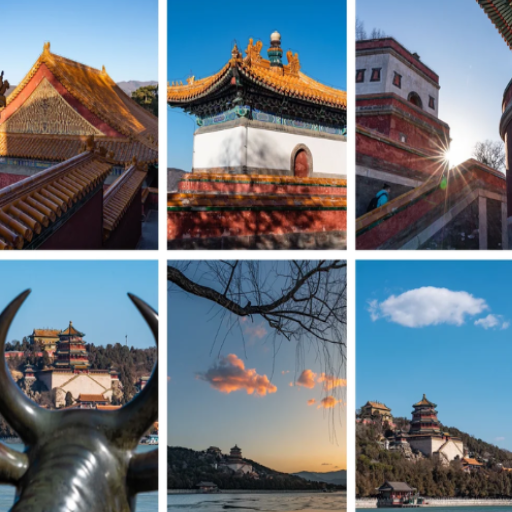
Best Time to Visit the Summer Palace for Optimal Experiences
Visiting the Summer Palace in late spring (April to June) or early autumn (September to October) is ideal. During these times, the average temperature is between 15°C and 25°C (59°F to 77°F), suitable for walking and sightseeing. The natural beauty of these seasons is astonishing, as flowers bloom in spring and gold leaves decorate the landscape in autumn.
If you want to escape the crowds, the best way to do so is by visiting particularly early in the morning or on weekdays, excluding major holidays. For calm and peaceful experiences, mild and sunny winter days are best for amazing captures of the architecture’s intricate details and Kunming Lake’s reflection.
Summer Palace Tickets: Booking Options and Prices in CNY
Based on ticketing preferences and desired areas of exploration, visitors to the Summer Palace have several options. Tickets are purchased in Chinese Yuan (CNY), and their respective categories are:
Entry Ticket (Main Gate Only): Peak season 30 CNY, off-season 20 CNY.
Through Ticket (Includes Scenic Spots): Peak season 60 CNY, off-season 50 CNY.
Scenic Spot Add-ons:
Dehe Garden (Virtuous Harmony Garden) 5 CNY.
Tower of Buddhist Incense (Foxiang Pavilion) 10 CNY.
Suzhou Street and Danning Hall 10 CNY.
Advance Purchase:
Minimizing wait time, tickets can be purchased with a few clicks on official platforms.
Ticket purchasing counters are available at the location for those who prefer in-person buying.
Queues can become very long during peak season, so purchasing tickets in advance is encouraged. Tickets are reasonably priced due to the maintenance needed to preserve the UNESCO site and its culturally and historically significant heritage. Optional guided tours can be purchased for those interested in the palace’s rich history.
Private Tour vs. Group Tour: Which Summer Palace Experience is Right for You?
Your expected experiences, preferences, and budget for the trip to Summer Palace determines your choice of a private or group tour.
Private Tour
Personalized Experience: Comes with a guide who is fully available for the undivided attention of a traveler with a specific area of interest and flexibility in changing plans.
Privacy and Comfort: Ideal for couples, families, or small groups motivated to have a more personal experience without larger group distractions.
Cost: These are the most exclusive options, which makes them the most expensive.
Time Management: Freedom to move around without a set timetable.
Group Tour
Cost-Effective: A less expensive style of tourism that is available to solo travelers or budget-friendly visitors.
Social Interaction: Encourages interactions with other travelers and participation in the experience.
Fixed Itinerary: Plans are drawn up in advance to be followed, reducing the scope of independent personal exploration.
Guide Availability: Less personal attention since guides are shared.
As seen here, the private tour is well-suited to those who appreciate personalized service and flexibility. In contrast, a group tour answers cost-conscious travelers who want to socialize.
What Are the Must-See Areas Within the Yiheyuan?
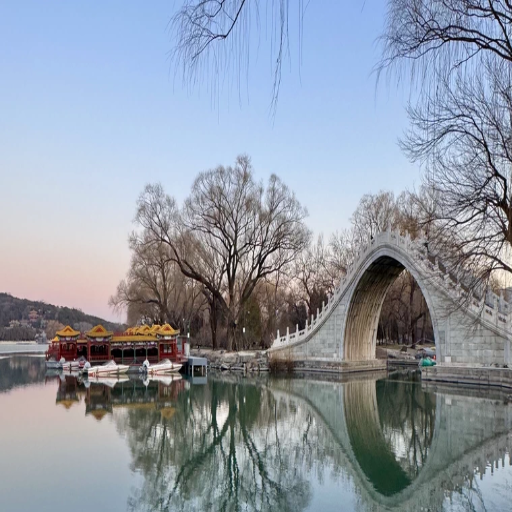
Kunming Lake and the Iconic Marble Boat
Kunming Lake is one of the highlights of Yiheyuan. Together with the other components, it makes up almost three-quarters of the four hundred-fifty-acre garden. Its design is based on the behavior of the West Lake in Hangzhou and exemplifies nature with the beauty of architecture. Visitors can enjoy the soothing landscapes or ride a leisurely paddle boat by walking around the lake’s perimeter.
The Marble Boat, also known as The ‘Boat Of Purity and Ease, ‘ is a stationary resort pavilion built for the Qianlong emperor. It was constructed mostly using marble and other materials, though to a lesser extent, in the form of a wooden ship, the aim was to showcase stability and durability of the Qing dynasty. The boat, about 36 meters long, has exquisite carvings portraying the artistry of the then civilization, which was considered superlative. Both Kunming Lake and the Marble Boat are significant markers of the rich cultural history of Yiheyuan.
Longevity Hill: Pavilions, Temples and Spectacular Views
Rising majestically over Kunming Lake, Longevity Hill completely dominates the surrounding landscape, and its view is breathtaking. The pavilions, temples, and ornate covered walkways built on the hill reflect the sophistication of art and architecture during the Qing Dynasty and showcase superb craftsmanship. One of the most renowned structures includes the Tower of Buddhist Incense (Foxiang Ge), symbolizing religious devotion and architectural mastery like a guiding lamp. Serving as an alternatively aesthetic and spiritual structure at 41 meters (about 135 feet) tall, this tower blends devout natural intricacies while showcasing a stunning fusion of herculean human creativity.
Furthermore, the Hill serves another purpose since its location allows it to touch the feng shui harmony of the imperial gardens. Considering these structures from the perspective of natural illumination and anthropogenic height, they not only make the view pretty but are also a sign of the sophisticated engineering of the epoch. In this case, these features are quite rational because, along with the deep meaning of the imperial resort, the aim was both tranquil and grand.
The Famous Long Corridor: Art and Architecture Along Beijing’s Most Beautiful Walkway
Located at the Summer Palace, the Famous Long Corridor of Beijing is an extraordinary architecture and engineering art piece. Personally, what makes it the most important is how it integrates nature, culture, and usefulness, working together flawlessly. The hallway has marvelous paintings that mark cultural heritage and depict mythical stories and multiple historical events.
Its orientation is designed to prevent too much light while enhancing the bright artwork on display, ensuring the vivid parts of art are showcased in the best possible way. The corridor’s elevation allows the structure to endure seasonal floods, which shows how thoughtfully designed the area is. These elements contribute to the practicality, beauty, and significance of the Long Corridor, one of Beijing’s most important architectural wonders.
How to Get to the Summer Palace and Navigate the Grounds?
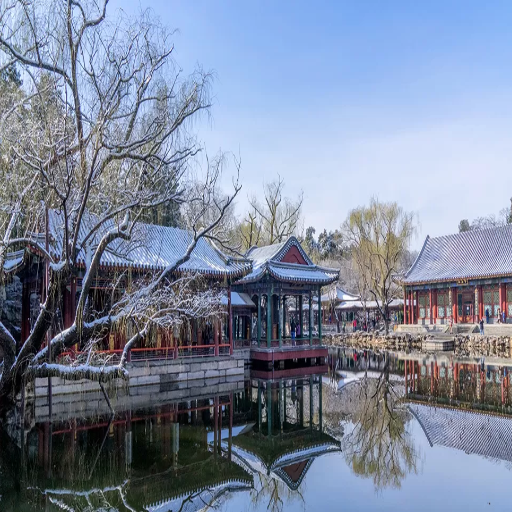
Beijing Subway Routes to the North Palace Gate and New Palace Gate
To access the Summer Palace through the North Palace Gate, take Line 4 of the subway and get off at Beigongmen (North Palace Gate) Station. Use Exit D; after 5 minutes of walking, you will arrive at the gate. This route is perhaps the best in terms of efficiency and benefits tourists.
To reach the New Palace Gate, take Line 4 of the subway and exit at Xiyuan Station. Take Exit C2. You must walk roughly 15 minutes to the New Palace Gate. Alternatively, you can take a bus from this Stop, which will shorten the walk, depending on the individual.
Both options are simple and made easier by Beijing’s extensive subway system. They both lead to the Summer Palace. The recommended routes will provide accurate and reliable information for travel purposes and, ultimately, save the most time.
Full-Day vs. Half-Day Tour: Planning Your Visit to the Summer Palace
Choosing between a full-day or half-day tour of the Summer Palace depends on your interests and schedule. In my case, I would suggest a full-day tour if you would like to cover the top spots such as Longevity Hill, Kunming Lake, and the Pavilions and Towers. You would appreciate the area’s history, relax with a boat ride on Kunming Lake, and enjoy a cultural performance if there is one on offer. This option usually takes around 6-8 hours to complete.
If you’re visiting in a hurry, a half-tour takes about 3-4 hours, which is shorter but still might be worth it. You might be able to see most of the main sights, like the Long Corridor and Marble Boat, while admiring the beautiful scenery. Those with busier schedules or looking to visit other sites in Beijing after visiting the palace would typically find this better suited to their needs.
Optimal Start Time: If you choose to explore during a full-day visit, try to arrive as early as possible (around 8 to 9 a.m.) to maximize time. However, a half-day tour could be started far later in the day.
Physical Endurance: Walking may be the most exerting part of a full-day visit, so good shoes are recommended if you plan to explore the large areas of the palace’s grounds. You will also be asked to walk for a moderate amount during the half-day tours.
Budget: Balancing ticket purchasing with supplementary expenses such as boat rides or optional guide services proves more manageable for a full-day itinerary as ticket prices are consistent between half and full-day tickets.
Transportation: Time your walking and subway plans. Both gates (North Palace Gate and New Palace Gate) support rapid entry for half-day or full-day excursions.
Ultimately, it comes down to how much time you wish to spend on this beautiful cultural heritage.
Walking Routes and Sightseeing Maps of the Palace Grounds
I suggest developing a walking strategy for the palace perimeter based on your time duration and particular interest. For example, if you are on a multi-day trip, it would be better to start from the New Palace Gate and follow the comprehensive route, including the reception dawning palaces and the scenic gardens and beautiful lakes. This portion is planned so that you can cover everything rather relaxed. In the case of a half-day visit, entering from the North Palace Gate permits covering the major attractions, such as the main halls and the courtyards around them, in reasonable depth.
Time Efficiency: A full-day route usually requires 6-8 hours of walking and covers 5-6 miles, while a half-day route requires 3-4 hours of walking and covers 3 miles. Both plans involve wearing comfortable footwear.
Navigation Tools: The official sightseeing maps available at the entrance gates are helpful. Another option would be a digital map application with GPS that would allow you to remain on track.
Accessibility Considerations: Some places, for example, on the elevated lookout points, aka pagodas, have steep pathways. If this issue needs to be solved, smoother routes can be provided in the maps that enable more accessibility.
In the end, which option you choose primarily boils down to how much time you want to commit, however both choices guarantee an unforgettable experience with this landmark.
What Additional Sites Can Be Combined with Your Summer Palace Tour?
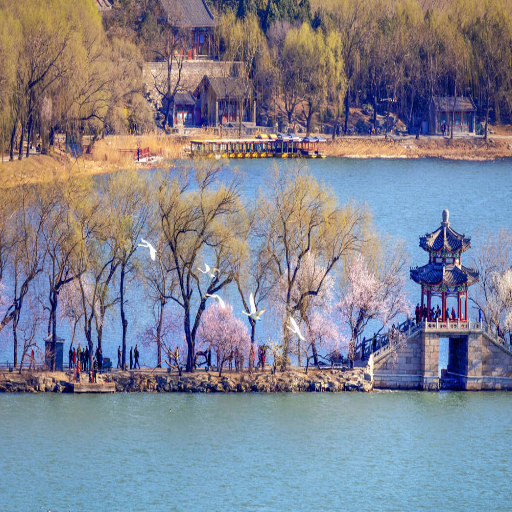
Summer Palace and Temple of Heaven: Perfect Beijing Day Trip Combination
An ideal one day trip to Beijing can be easily done by visiting The Summer Palace and Temple of Heaven. An early start to the day gives you enough time to visit both landmarks without rushing. I recommend allocating around 3-4 hours to The Summer Palace and spending that time on the main focus points like Kunming Lake and Longevity Hill. After lunch, make your way to the Temple of Heaven. It usually takes 2-3 hours to visit the main areas like the Hall of Prayer for Good Harvests and the Circular Mound Altar.
Travel Distance: The distance between The Summer Palace and The Temple of Heaven is roughly 25 kilometers. Make sure to allocate a minimum of 1-1.5 hours for commuting, as time can vary due to traffic and your mode of transport, which can be a subway, private car, or taxi.
Tourist Entry Fees: Do not forget to account for different entrance fees for each location. The Summer Palace takes around 30-60 rmb depending on season and ticket type, while The Temple of Heaven charges around 15-30 rmb.
Walking Distance: Considerable walking has to be done at both venues. Comfortable shoes and weather-appropriate clothing are a must.
Access to Both Sites: Each site has irregular textures and ranges of historical walking paths. If there are mobility issues, you may need to alter your journey to the most accessible portions, which are more suitable for wheelchairs or less fragmented paths.
Combining both sites, with some planning regarding timing and logistics, provides a more complete experience of Beijing’s rich history and architecture.
Exploring Suzhou Street and Other Hidden Gems Near the Summer Palace
If you wish to visit Suzhou Street, set aside one to two hours. This stop offers a fantastic view of the historical buildings alongside shops that retain a traditional style. Entrance is included in specific combination tickets to the Summer Palace, so check your ticket type to avoid disappointment.
Check out Yiyun Hall and hike to the Foxiang Pavilion for views of the surroundings. Both locations require walking or climbing, so wear proper walking shoes. For those with accessibility concerns, some approaches to these features have steps or rough ground, so there are better places to smooth them out.
Doing these additional features and planning your visit to Suzhou Street enables a more intimate appreciation of the landscape and the history of the Summer Palace. Any logistical issues arising from clothing, ticket inclusions, or requirements for accessibility should be taken care of before a more relieving experience.
Beijing City Tour Options that Include the Summer Palace
I suggest searching for packaged or customizable sightseeing tours for Summer Palace tours or other noteworthy landmarks in Beijing. These tours often amalgamate several points of interest, such as the Temple of Heaven or Forbidden City, into one convenient package. Such packages typically include tickets to the Summer Palace; however, it is essential to ascertain whether particular parts of the palace, including Suzhou Street and Foxiang Pavilion, are covered by your ticket, as certain regions have different ticketing systems or require payment of an additional charge.
Included in Packages: Ensure which sections of the Summer Palace are included. Specific tours only offer general admission, not including access to other smaller attractions like Suzhou Street.
Transportation: Review what type of transport is covered in the package (private, shared bus, metro guidance).
Agreement: Inquire into the walking limitations and whether any provisions are made for challenging walkways or stairs at Foxiang Pavilion.
Clothing Suggestions: Comfortable and weather-appropriate clothing and shoes are ideal as considerable walking and outdoor activity occurs during the tour.
By tackling these issues ahead of time, you may personally select a tour that suits your preferences and guarantees a hassle-free experience. Ultimately, it is balancing what you want against the arrangements provided in the tour for a fulfilling visit to the Summer Palace and not only.
Frequently Asked Questions (FAQs)
Q: How can I get the most out of my trip to the Summer Palace in Beijing?
A: An experience at the Beijing Summer Palace immerses you in one of China’s grandiose imperial gardens. You’ll visit the stunning temples, beautiful bridges, impressive pavilions, and the famous marble boat. Most tours include knowledgeable guides that narrate the history of the palace and the impact Empress Dowager Cixi had on its construction. The breathtaking lakes, serene Kunming Lake, and beautiful Garden of Virtue and Harmony in the 290-acre scenic area make it appear as a summer retreat for the tourists who visit during peak season. It is regarded by many of its visitors as one of the top pieces of Chinese landscape design and serves as a fantastic getaway from the bustling city center of Beijing.
Q: Where can I purchase tickets to the Summer Palace?
A: You can purchase tickets to the Summer Palace directly from the official Palace Museum website or through Websites like Trip Advisor, GetYourGuide, Viator, and many others. A plethora of tour packages with free payment cancellation policies are accessible. To avoid long queues and get the best value, reserving the tickets online and ahead of time is preferable, especially during peak tourist times. Tickets range from 20 to 30 CNY for basic admission and an additional fee for specific attractions inside, like the Garden of Virtue and Harmony and the Hall of Jade Ripples.
Q: What are the attractions I can visit around the Summer Palace?
A: Several attractions near the Summer Palace are of equal importance. The Old Summer Palace (Yuanmingyuan) ruins are just a stone’s throw away, which provides historical context. Fragrant Hills Park is ideal for nature lovers during autumn. Art lovers will appreciate the Beijing Art Museum, which is also located quite close. You may enjoy the lovely campus of Tsinghua University, Zhongguancun (China’s Silicon Valley), or the Beijing Botanical Garden. Many tourists bundle the Summer Palace and Temple of Heaven or Tiananmen Square, although those involve some extra traveling.
Q: At what time can someone expect to finish their tour of the Summer Palace?
A: To properly visit the main attractions, a Summer Palace tour requires at least half a day (i.e., 3-4 hours). Many tourists spend an entire day here taking in this imperial garden and its landmarks. This may include some combination of Long Corridor, Longevity Hill, Hall of Benevolence and Longevity, and a boat ride around the lake or climbing the numerous hills in the park. The Garden of Harmonious Interests and Nanhu Island may also be explored with extra time supplements.
Q: What is the most efficient way to visit the Summer Palace?
A: To truly appreciate the Summer Palace, being accompanied by a well-versed tour guide is your best option. His or her knowledge on the Imperial Garden’s history and its numerous tales will allow you to experience the palace fully. During the summer, prepare to wake up early to avoid both crowds and the intense heat. Most popular starting routes include the East Palace Gate, through the Long Corridor, which contains an astounding 14,000 paintings, up Longevity Hill, to the Tower of Buddhist Incense, and down towards the lake. The unique views of the palace and Seventeen-Arch Bridge from Kunming Lake allow for ideal boating opportunities. Consider visiting in Spring or Autumn if you’re looking for the most comfortable temperatures.
Q: Is it challenging to reach Summer Palace by public transport?
A: No, it is not difficult to reach the Summer Palace. Its public transportation connections are extensive. The easiest method is to take subway Line 4 to Beigongmen (North Palace Gate) or Xiyuan station. There is a minimal distance from each station to walk to the palace entrances. Many public buses cover this area as well. For people lodging around the city’s center by landmarks, such as Tiananmen Square, it takes 40-50 minutes to get there by subway. Taxis, while public transport, are susceptible to traffic as well. Most tour packages come with hotel capture and drop-off services tailored for ease of use.
Q: What is the historical significance of the Summer Palace?
A: The Summer Palace is of great historical importance as a royal garden first constructed in 1750 during Emperor Qianlong’s reign. It acted as an imperial escape during summer for emperors trying to avoid the stifling heat of the Forbidden City. It was primarily destroyed during the Anglo-French invasion of 1860 but was restored at the expense of China’s naval funds after being appropriated by Empress Dowager Cixi. Although this decision was highly controversial as it weakened China’s military, it preserved what is now a masterpiece of Chinese garden design. In 1998, UNESCO listed the Summer Palace as a World Heritage Site for its unnatural and natural features, which are said to be influenced by the gardens from Hangzhou and other southern parts of China.
Q: Is there anything I should note regarding cancellation policies for Summer Palace tours?
A: The most reliable tour operators usually offer flexible cancellation policies that provide Summer Palace tours. For example, GetYourGuide and Viator typically have a system that allows cancellations without charge 24 hours before the tour. Some premium packages allow cancellation without charge up to three days prior. However, each provider and tour type has its own set of rules, so one must check the specific terms before booking. There are also stricter policies during popular seasons or around certain holidays. If you anticipate changes to your travel plans, look for free cancellation tour options to provide you with more flexibility.